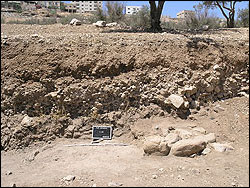In the course of fieldwork undertaken at several Late Pre-Pottery Neolithic (LPPNB/PPNC) and early Pottery Neolithic (PN) sites in southern Jordan, Project F1 is investigating a phenomenon known among specialists as “Yarmoukian Rubble Slides”.
This phenomenon is expressed as layers of fist-sized rubble, sometimes with a depth of in excess of 1 m, which cover parts of LPPNB sites, and appear to mark a caesura in the occupation sequence. The term “Yarmoukian” refers to the presumed age of these layers and is given to earliest pottery producing societies in the southern Levant (from c. 6,200 calBC) which supersede LPPNB/PPNC.
Our research concentrates on two major aspects of these rubble layers: (1) Are they really Yarmoukian in date? (2) Is their genesis related to abrupt climate change which occurred in the region in the 7th millennium calBC? Preliminary results from geomorphological studies suggest that the rubble layer genesis was (1) not associated with torrential rainfall events (as was initially posited), but is indeed (2) related to widespread abandonment of LPPNB/PPNC sites, which may have a climatic background. Further, new radiocarbon dates reveal that the accumulation of rubble layers was not restricted to the Yarmoukian period.
 “Yarmoukian Rubble Layer” as documented at ‘Ain Ghazal, Amman (Jordan). Photo: Courtesy Gary Rollefson |









